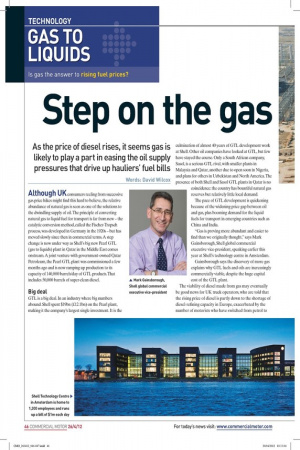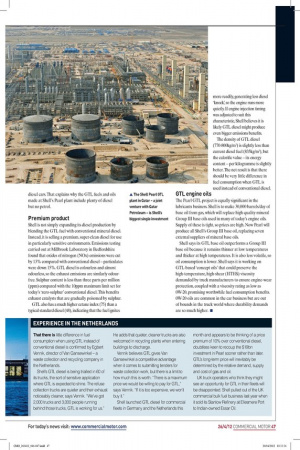Step on the gas
Page 38

Page 39

If you've noticed an error in this article please click here to report it so we can fix it.
As the price of diesel rises, it seems gas is likely to play a part in easing the oil supply pressures that drive up hauliers’ fuel bills
Words: David Wilcox Although UK consumers reeling from successive gas price hikes might find this hard to believe, the relative abundance of natural gas is seen as one of the solutions to the dwindling supply of oil. The principle of converting natural gas to liquid fuel for transport is far from new – the catalytic conversion method, called the Fischer-Tropsch process, was developed in Germany in the 1920s – but has moved slowly since then in commercial terms. A step change is now under way as Shell’s big new Pearl GTL (gas to liquids) plant in Qatar in the Middle East comes onstream. A joint venture with government-owned Qatar Petroleum, the Pearl GTL plant was commissioned a few months ago and is now ramping up production to its capacity of 140,000 barrels/day of GTL products. That includes 50,000 barrels of super-clean diesel. ▲ Mark Gainsborough, Big deal executive vice-president GTL is a big deal. In an industry where big numbers abound. Shell spent $19bn (£12.1bn) on the Pearl plant, making it the company’s largest single investment. It is the culmination of almost 40 years of GTL development work at Shell. Other oil companies have looked at GTL, but few have stayed the course. Only a South African company, Sasol, is a serious GTL rival, with smaller plants in Malaysia and Qatar, another due to open soon in Nigeria, and plans for others in Uzbekistan and North America. The presence of both Shell and Sasol GTL plants in Qatar is no coincidence: the country has bountiful natural gas reserves but relatively little local demand.
The pace of GTL development is quickening because of the widening price gap between oil and gas, plus booming demand for the liquid fuels for transport in emerging countries such as China and India.
“Gas is proving more abundant and easier to find than we originally thought,” says Mark Gainsborough, Shell global commercial executive vice-president, speaking earlier this year at Shell’s technology centre in Amsterdam.
Gainsborough says the discovery of more gas explains why GTL fuels and oils are increasingly commercially viable, despite the huge capital cost of the GTL plant.
The viability of diesel made from gas may eventually be good news for UK truck operators, who are told that the rising price of diesel is partly down to the shortage of diesel-refining capacity in Europe, exacerbated by the number of motorists who have switched from petrol to diesel cars. That explains why the GTL fuels and oils made at Shell’s Pearl plant include plenty of diesel but no petrol.
Premium product
Shell is not simply expanding its diesel production by blending the GTL fuel with conventional mineral diesel. Instead, it is selling a premium, super-clean diesel for use in particularly sensitive environments. Emissions testing carried out at Millbrook Laboratory in Bedfordshire found that oxides of nitrogen (NOx) emissions were cut by 13% compared with conventional diesel – particulates were down 15%. GTL diesel is colourless and almost odourless, so the exhaust emissions are similarly odourfree. Sulphur content is less than three parts per million (ppm) compared with the 10ppm maximum limit set for today’s ‘zero-sulphur’ conventional diesel. This benefits exhaust catalysts that are gradually poisoned by sulphur.
GTL also has a much higher cetane index (75) than a typical standard diesel (48), indicating that the fuel ignites more readily, generating less diesel ‘knock’, so the engine runs more quietly. If engine injection timing was adjusted to suit this characteristic, Shell believes it is likely GTL diesel might produce even bigger emissions benefits.
The density of GTL diesel (770-800kg/m3) is slightly less than current diesel fuel (835kg/m3), but the calorific value – its energy content – per kilogramme is slightly better. The net result is that there should be very little difference in fuel consumption when GTL is used instead of conventional diesel.
GTL engine oils
The Pearl GTL project is equally significant in the lubricants business. Shell is to make 30,000 barrels/day of base oil from gas, which will replace high-quality mineral Group III base oils used in many of today’s engine oils. Supply of these is tight, so prices are high. Now Pearl will produce all Shell’s Group III base oil, replacing seven external suppliers of mineral base oils.
Shell says its GTL base oil outperforms a Group III base oil because it remains thinner at low temperatures and thicker at high temperatures. It is also less volatile, so oil consumption is lower. Shell says it is working on GTL-based ‘concept oils’ that could preserve the high-temperature, high-shear (HTHS) viscosity demanded by truck manufacturers to ensure engine-wear protection, coupled with a viscosity rating as low as 0W-20, promising worthwhile fuel consumption benefits. 0W-20 oils are common in the car business but are out of bounds in the truck world where durability demands are so much higher. n
EXPERIENCE IN THE NETHERLANDS
That there is little difference in fuel consumption when using GTL instead of conventional diesel is confirmed by Egbert Vennik, director of Van Gansewinkel – a waste collection and recycling company in the Netherlands.
Shell’s GTL diesel is being trialled in 60 of its trucks, the sort of sensitive application where GTL is expected to shine. The refuse collection trucks are quieter and their exhaust noticeably cleaner, says Vennik. “We’ve got 2,000 trucks and 3,000 people running behind those trucks, GTL is working for us.” He adds that quieter, cleaner trucks are also welcomed in recycling plants when entering buildings to discharge.
Vennik believes GTL gives Van Gansewinkel a competitive advantage when it comes to submitting tenders for waste collection work, but there is a limit to how much this is worth. “There is a maximum price we would be willing to pay for GTL,” says Vennik. “If it is too expensive, we won’t buy it.” Shell launched GTL diesel for commercial fleets in Germany and the Netherlands this month and appears to be thinking of a price premium of 10% over conventional diesel, doubtless keen to recoup the $19bn investment in Pearl sooner rather than later. GTL’s long-term price will inevitably be determined by the relative demand, supply and cost of gas and oil.
UK truck operators who think they might see an opportunity for GTL in their fleets will be disappointed. Shell pulled out of the UK commercial bulk fuel business last year when it sold its Stanlow Refinery at Ellesmere Port to Indian-owned Essar Oil.











































